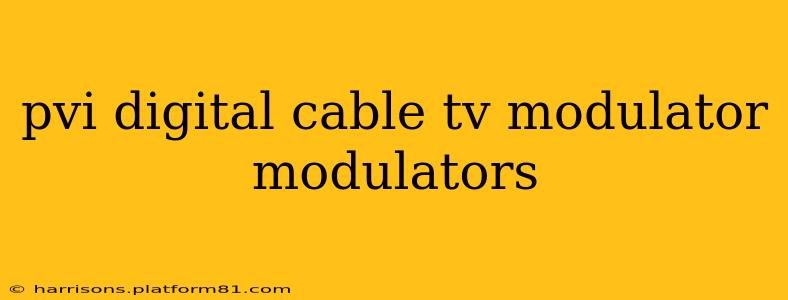Finding the right digital cable TV modulator can be tricky, but understanding their function and features is key to making an informed decision. This guide dives deep into PVI digital cable TV modulators, exploring their capabilities and helping you determine if one is the right choice for your needs.
What is a Digital Cable TV Modulator?
A digital cable TV modulator converts digital cable signals into a format compatible with older analog TVs or devices that lack integrated digital tuners. Essentially, it acts as a bridge between your modern cable system and older equipment, allowing you to watch digital cable channels on these older devices. PVI, a reputable brand in the electronics industry, offers a range of such modulators, each with its own specifications and features.
Why Choose a PVI Digital Cable TV Modulator?
PVI modulators are known for their reliability and performance. They often provide clear picture quality and stable signal transmission, ensuring a consistent viewing experience. Choosing a PVI modulator often means investing in a product built with quality components and designed for longevity. This is crucial, considering the investment in your cable service.
What are the Key Features to Consider in a PVI Modulator?
Several key features differentiate various PVI (and other brand) digital cable TV modulators:
- Input and Output Connections: Check for compatibility with your cable box and TV's connection types (e.g., coaxial, RF). Ensure the modulator supports the specific input and output connectors you need.
- Channel Selection: Some modulators allow you to select specific channels to output, while others might simply broadcast all channels received from your cable source.
- RF Output: This refers to the frequency at which the modulator outputs the signal. Ensure your TV can receive this frequency.
- Power Supply: Determine if the modulator requires an external power adapter or if it draws power directly from the cable connection.
- Signal Amplification: Some modulators offer signal amplification to boost weak signals, improving picture quality, especially if you have a long cable run.
How Do I Connect a PVI Digital Cable TV Modulator?
Connecting a PVI digital cable TV modulator is usually straightforward. The general process involves connecting the output of your cable box to the modulator's input, then connecting the modulator's output to the antenna input of your older TV. Consult the specific instructions provided with your PVI modulator for precise connection details. Remember to always switch off your equipment before making any connections.
What are the Different Types of PVI Digital Cable TV Modulators?
While detailed model information isn't readily available publicly without specific model numbers, PVI likely offers variations in features like channel selection options, power requirements, and signal amplification capabilities. Checking online retailers and PVI's website (if available) is crucial for identifying the specific types and their specifications.
Are There Any Alternatives to PVI Modulators?
Yes, several other brands offer digital cable TV modulators. The best alternative for you will depend on your specific needs and budget. Research other reputable brands and compare their features and prices to find the most suitable option.
Troubleshooting Common Issues with PVI Modulators
If you encounter issues, troubleshooting steps might include:
- Checking Cable Connections: Ensure all connections are secure and correctly plugged in.
- Signal Strength: Weak signals can cause picture quality issues. Check your cable connection and consider a signal amplifier if necessary.
- Channel Selection: Ensure you've selected the correct channel on both the modulator and your TV.
- Power Supply: Make sure the modulator is receiving sufficient power.
By understanding these factors and considering your specific requirements, you can choose the right PVI digital cable TV modulator to enjoy your cable service on older television sets. Remember to consult user manuals and reviews before purchasing to confirm compatibility and performance.
